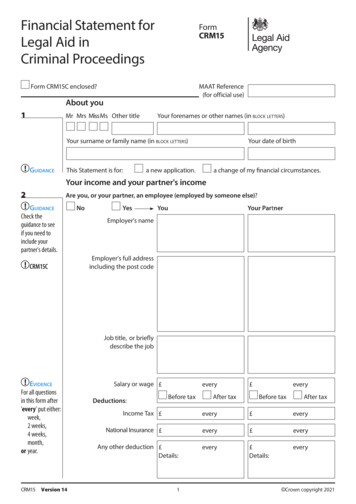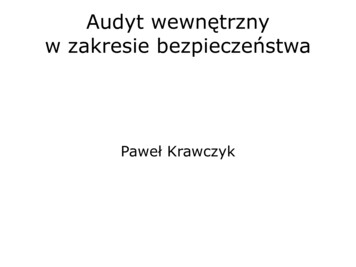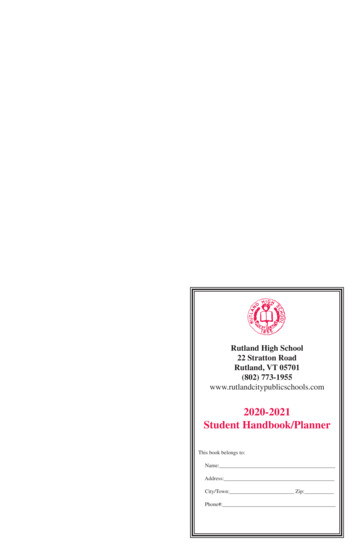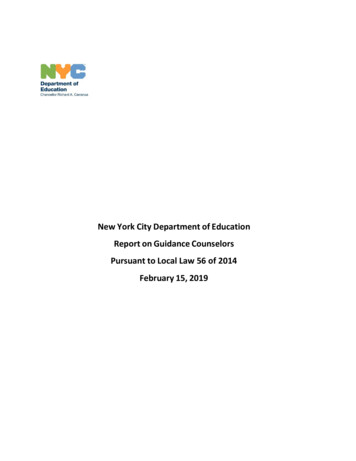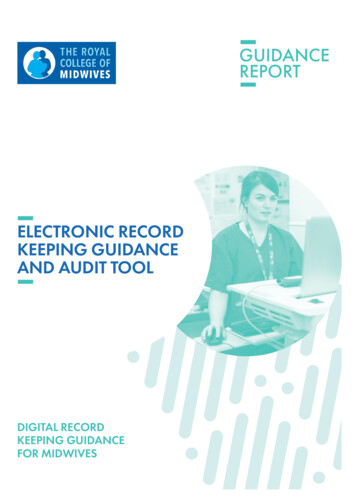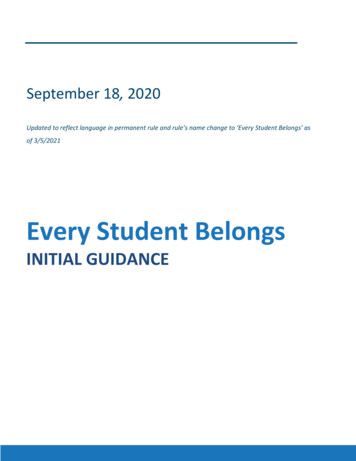
Transcription
September 18, 2020Updated to reflect language in permanent rule and rule’s name change to ‘Every Student Belongs’ asof 3/5/2021Every Student BelongsINITIAL GUIDANCE
Every Student Belongs Initial GuidanceTable of ContentsCover Letter . 1Background . 4State Law . 5Every Student Belongs Rule . 5Initial Guidance . 51) Acknowledging Harm, Harm Reduction, and Response . 6(a) Acknowledging Harm . 6(b) Harm Reduction . 6(c) Healing-Centered, Trauma-Informed Response . 72) Developing Policy . 73) Developing Procedures . 94) Complaint Process. 115) Resources . 11Cover LetterDear Superintendents,I’m writing to you about an important health and safety rule passed by the State Board ofEducation: 581-022-2312 Every Student Belongs.ODE recognizes that student health and safety are at the cornerstone of education and thatevery students is entitled to a high-quality educational experience, free from discriminationor harassment based on perceived race, color, religion, gender identity, sexual orientation,disability, or national origin, and without fear or hatred, racism or violence. Staff and leadersare also entitled to work in environments that are free from discrimination or harassment, andvisitors should be able to participate in school activities without fear for their safety.1
Every Student Belongs Initial GuidanceThe Every Student Belongs OAR is an important step in creating safe and inclusive schoolclimates where all who participate in our school communities feel welcome.BackgroundThis past July, an Oregon high school student sent a letter to Governor Kate Brown asking forhelp. In the letter, the student stressed the importance of banning the Confederate flag inOregon public schools. In the student’s words, “Banning the Confederate flag is far more thanjust an act to please some people. It shows students and educators that the State of Oregonsees them in their struggles to be considered equal and aiding in the fight against racism Right now is a great time for Oregon to be a leader for its own citizens and throughout theUnited States and install this overdue policy.”This student’s experience is not alone. In the last few years alone ODE has receivedcomplaints or been made aware of multiple incidents involving hate symbols such as symbolsof neo-Nazi ideology or the battle flag of the Confederacy, and nooses. These incidents havedisrupted education for students across Oregon.In response, Governor Brown wrote to the State Board of Education Chair and me urging us“to take immediate action to address and correct the adverse impacts symbols of hate andother manifestations of hate speech have on students in Oregon public schools.” Sherequested that the Board establish rules to ensure that no Oregon student “be subject toactions or expressions of hate, intolerance, marginalization, or racism.” The Board received asimilar letter from Representatives McKeown and Brock-Smith asking it to take immediateaction.This student and others from across Oregon have come forward to show us the extremedisruption and harm that hate symbols cause. When we hear from students that their safety,mental health, well-being and ability to learn are threatened, we must listen, trust, and takeimmediate action. This policy change begins that action.In Oregon, we value both freedom and responsibility, and are charged with ensuring thatEvery Student Belongs. This means affording our school communities the freedom ofexpression while removing barriers to students’ educational progress, including theprohibition of display of hate symbols that incite fear and violence, and cause emotionaldistress and trauma. The presence of symbols of hate on the basis of race, color, religion,gender identity, sexual orientation, disability or national origin causes harm, and significantlydisrupts the operation of schools. When one person in a school community is treated poorly,everyone suffers.At the instruction of Governor Brown, the Oregon Board of Education has enacted the EveryStudent Belongs rule, which prohibits hate symbols, including three of the most recognizablesymbols of hate—the noose, symbols of neo-Nazi ideology and the battle flag of theConfederacy. The temporary OAR took effect on September 18, 2020 and was made2
Every Student Belongs Initial Guidancepermanent on February 18th, 2021. It requires districts to adopt and implement policies andprocedures that prohibit the use or display of hate symbols including the noose, symbols ofneo-Nazi ideology or the battle flag of the Confederacy in any program or school-sponsoredactivity except where used in teaching curriculum that is aligned with the Oregon StateStandards by January 1, 2021. This applies to both in-person and distance learningenvironments.Safety and HealthAs with all OARs, the safety and health of students is our first priority. Discrimination,exclusion, othering, harassment and the use of hate symbols and hate speech are complexand multifaceted, and often reflect systemic problems rather than individual shortfalls. Swiftdisciplinary actions, zero-tolerance policies and other punitive responses frequently ignorethis multidimensionality in favor of immediate resolution. These approaches do little to alterthe attitudes and biases that resulted in the negative, and often violent behavior, and providelittle chance for growth, healing or understanding.Trauma-informed, healing-centered, and educational approaches will be needed to address theroot causes and consequences of these harmful acts, and to create opportunities for educationand learning while avoiding blame, punishment, or further exacerbating the attitudes andbiases that may have prompted the initial event(s). We will continue to support school districtsin developing rules, policies, and procedures by providing guidance and resources to supportimplementation of these policies over the next several months.Together, we must protect the health of our school communities by removing any and allbarriers that impede a student’s ability to thrive. Students have asked that the state as a wholefollow their lead. We trust in young people and communities throughout Oregon to lead us intoa future where students, staff and families are welcome in our school communities. It is ourcollective responsibility to make certain that Every Student Belongs.Thank you for supporting the health and safety of our students and educators. Please reviewthe guidance we’ve paired with this letter and submit any questions or suggestions toAllStudentsBelong@state.or.us.Sincerely,Colt GillDirector of the Oregon Department of Education3
Every Student Belongs Initial GuidanceBackgroundOregon school communities are the bedrock of our children’s learning, development, andflourishing. Each district and school is responsible for ensuring that their students, families, staffmembers, and leaders belong. This involves actively adopting and implementing rules, policies,and practices that promote equity and inclusion, and standing up against harmful and racistacts that run counter to these values.Oregon’s youth and their families entrust the adults in their schools with students’ health andwell-being, and rely on school communities to be welcoming and inclusive. Acts such asbullying, harassment, discrimination, intimidation, dismissal, using hate speech and symbols,and creating environments where some are excluded, marginalized, or discounted givestudents the message that they are not welcomed, valued, or important. Thesecommunications, whether intentional or unintentional, can, and do, cause immediate, andsometimes irreparable harm. No student is immune from being a recipient of these acts, andmost will be physically, mentally, or emotionally injured by them in some way.School districts and the adults within them have the responsibility to make sure that this doesnot occur, and that students are safe, included, and free from harm. When students ormembers of a school community experience hate or racism, whether directly through words,actions, or symbols, or indirectly through exclusion or inequitable access to resources, theirsafety, health, well-being, and ability to learn and thrive are compromised. These experiencescause stress, which puts everyone involved; those who are harmed, those who cause suffering,and those charged with responding, at elevated risk for physical, emotional, and social illness.In other words, when one person in a school community is treated poorly, everyone is affected.Discrimination, exclusion, othering, harassment, and the use of hate symbols and hate speechare complex and multifaceted, and often reflect systemic problems rather than individualshortfalls. Swift disciplinary actions, zero-tolerance policies, and other punitive responsesfrequently ignore this multidimensionality in favor of immediate resolution. They do little toalter the attitudes and biases that resulted in the negative, and often violent behavior, andprovide little chance for growth, healing, or understanding.Trauma-informed, healing centered approaches that address the root causes and consequencesof these harmful acts need to account for these systemic factors by creating opportunities foreducation and learning while avoiding blame, punishment, and disciplinary strategies that canfurther exacerbate the attitudes and biases that may have prompted the event(s).4
Every Student Belongs Initial GuidanceState LawThe Oregon Legislature has determined that a person may not be subjected to discrimination inany public elementary, secondary, or community college education program or service, schoolor interschool activity or in any higher education program or service, school or interschoolactivity where the program, service, school or activity is financed in whole or in part by moneysappropriated by the Legislative Assembly.It is the policy of the State Board of Education that students, employees, and visitors in publicschools are entitled to learn, work, and participate in an environment that is safe and free fromdiscrimination, harassment, and intimidation.Every Student Belongs RuleThe presence of symbols of hate on the basis of race, color, religion, gender identity, sexualorientation, disability, or national origin including the noose, symbols of neo-Nazi ideology orthe battle flag of the Confederacy create a material and substantial disruption in schoolactivities and the learning environment by creating an atmosphere of fear and intimidation andinterfere with the rights of students by denying them full access to the services, activities, andopportunities offered by a school.First, school districts, public charter schools, the Oregon School for the Deaf, Education ServiceDistricts, Youth Corrections Education Program providers under contract with the OregonDepartment of Education, Juvenile Detention Education Program providers under contract withthe Oregon Department of Education, or a program that receives money pursuant to ORS343.243, must prohibit the use or display of any noose, symbols of neo-Nazi ideology or thebattle flag of the Confederacy on school grounds or in any program, service, school, or activitywhere the program, service, school, or activity is financed in whole or in part by moneysappropriated by the Legislative Assembly except where used in teaching curriculum that isaligned the Oregon State Standards. This applies to both in-person and distance learningenvironments.Second, the rule requires districts to adopt policies and procedures for dealing with biasincidents.Initial GuidanceThis initial guidance document is intended to provide districts with resources to support theirdevelopment and implementation of policies and procedures in response to this administrativerule.5
Every Student Belongs Initial Guidance1) Acknowledging Harm, Harm Reduction, and Response(a) Acknowledging HarmAlthough not all incidents of discrimination, exclusion, displaying hate symbols, or using hatespeech may be intended to cause harm, their impact is hostile and detrimental nonetheless. Formany, viewing symbols such as symbols of neo-Nazi ideology or the battle flag of theConfederacy, and hearing hate speech and racial slurs cause physiological and psychologicalstress and emotional pain. In addition, they serve as emotional triggers for generational andhistorical trauma and race-based traumatic stress.The impacts of traumatic stress on a person’s physical, psychological and social emotionalhealth are potentially long-lasting and widespread. Behaviorally, stress reactions can includeincreased vigilance and suspicion, intensified sensitivity to threat, sense of a foreshortenedfuture, and reactions such as aggression, depression, anxiety, or substance use. Researchexamining the effects of stress on development find that chronic childhood stressors aresignificantly associated with poor long-term health outcomes, and are highly predictive of aheightened physiological stress response, which is tied to structural, functional, andneurochemical brain anomalies, and an increased risk of lifelong behavioral, emotional,psychosocial, and cognitive problems. This is particularly true to those who have experiencedrace-based traumatic stress, which is often associated with racial battle fatigue.(b) Harm ReductionIt is essential that all who participate in school communities address the sources and outcomesof the use of hate symbols, hate speech, and other racially-motivated, injurious behaviorsswiftly and straightforwardly. For the Oregon Department of Education, and the districts acrossthe state, this means protecting students, eliminating all policies and procedures that createthe conditions for harmful incidents to occur, and preventing or addressing these acts swiftlyand directly.In practice, this means that every school district, public charter school, the Oregon School forthe Deaf, Education Service District, Youth Corrections Education Program provider undercontract with the Oregon Department of Education, Juvenile Detention Education Programprovider under contract with the Oregon Department of Education, or a program that receivesmoney pursuant to ORS 343.243, enacts and enforces rules to prioritize, protect and assure themental, physical and social health and well-being of students, their families, staff, leaders,community partners and visitors This includes ensuring that students, employees, and visitorscan learn, work and participate in school activities, occurring on and off school grounds, thatare free from discrimination, harassment, and intimidation, and guarantees that students arewelcomed and belong.6
Every Student Belongs Initial Guidance(c) Healing-Centered, Trauma-Informed ResponseIt is important to recognize that bullying, harassment, discrimination, intimidation, dismissal,using hate speech and symbols, and creating environments where some are excluded,marginalized, oppressed, or discounted impact individuals and groups differently. Althoughmost students and adults have, or will experience adversity, not everyone will be traumatized.It is, however, essential that schools and districts recognize that being exposed to hate-basedevents can cause traumatic stress, and that students and adults may exhibit traumatic stressrelated symptoms such as sadness, anger, exhaustion, difficulty concentrating, sleeplessness,anxiety, hypervigilance, aggression, and avoidance of people and situations for weeks, monthsor even years after an incident.In working to address the impact of harmful acts including hate speech, exposure to hatesymbols, racism, and discrimination it is essential for those responsible for responding to theevent to recognize that: Each person must be given the freedom to define their experience for themselves.Individuals are not defined by their trauma, behavior, emotions, thoughts, or capacity tocommunicate, and their experience is distinct from their identity.Each person brings ways of knowing, personal, family and community support, andconnections to place and space that may be central to their healing.Responses to traumatic stress are dynamic, and may vary considerably from moment tomoment, or day to day.Safe, trusting relationships, and a recognition and affirmation of “what is” arefoundational for healing.The culture, policies, and practices of the institutions that were designed to protectstudents, such as schools, may be the very sources of their distress.The stigma around seeking support, and the dismissal of their concerns that studentsoften experience may prevent some from engaging in traditional approaches, and mayrequire creative, innovative alternatives to standard care.Under all circumstances, strengths-based, healing-centered/trauma-informed, racial equitycentered, multi-tiered systems of support are central to promoting mental health and healing.This means being explicitly responsive to each student’s linguistic and cultural heritage, andhonoring each individual’s values, funds of knowledge, and inherent strengths and challenges.2) Developing PolicyThe following definitions should be used when developing policies to address bias incidents andprohibit the use of symbols of hate:(a) “Bias Incident” means a person’s hostile expression of animus toward another person,relating to the other person’s perceived race, color, religion, gender identity, sexualorientation, disability, or national origin, of which criminal investigation or prosecution7
Every Student Belongs Initial Guidanceis impossible or inappropriate. Bias Incidents may include derogatory language orbehavior directed at or about any of the preceding demographic groups.(b) “Symbol of Hate” means a symbol, image, or object that expresses animus on the basisof race, color, religion, gender identity, sexual orientation, disability or nation originincluding the noose, symbols of neo-Nazi ideology or the battle flag of the Confederacy,and whose display:(A) Is reasonably likely to cause a substantial disruption of or materialinterference with school activities, or(B) Is reasonably likely to interfere with the rights of students by denying themfull access to the services, activities, and opportunities offered by a school.Most districts have existing policies and procedures for addressing discrimination incidents thatpose a threat to students and staff. Districts should use these existing resources as a startingpoint for developing and implementing a framework for responding to incidents in which hatesymbols or hate speech occur in both in-person and in distance learning situations. Pursuant toOAR 581-022-2312, on or before January 1, 2021, school districts, public charter schools, theOregon School for the Deaf, and Education Service Districts must adopt a policy that:(a) Affirms every student is entitled to a high quality educational experience, free fromdiscrimination or harassment based on perceived race, color, religion, gender identity,sexual orientation, disability, or national origin;1) Affirms every employee is entitled to work in an environment that is free fromdiscrimination or harassment;2) Affirms every visitor is entitled to participate in an environment that is free fromdiscrimination or harassment;3) Prohibits the use or display of any symbols of hate, including at a minimum the noose,symbols of neo-Nazi ideology or the battle flag of the Confederacy, on school grounds orin any program, service, school, or activity where the program, service, school, oractivity is financed in whole or in part by moneys appropriated by the LegislativeAssembly except where used in teaching curriculum that is aligned the Oregon StateStandards.These policies must also:(i) Prioritize, protect, and assure the mental, physical and social health of students,families, staff, and leaders. This includes removing any and all barriers that interfere with astudent’s well-being, belonging, and ability to thrive; and(ii) Assure that every effort will be made to educate those committing the offenseregarding the impact of their actions with appropriate, non-punitive remedial measures.Some suggested references include A Framework for Safe & Successful School’s PositiveDiscipline or Oakland Unified School District’s Restorative Justice Whole SchoolImplementation Guide will be enacted.8
Every Student Belongs Initial GuidanceWe also suggest that you engage in immediate and ongoing communication of the rationale forthis rule and associated district policies to all students, families, staff, and school communitymembers.We have provided a Toolkit that includes these talking points to assist you in that process in theresources section at the end of this document.We recognize that changes to existing policies and procedures may require facilitatedconversations with school boards, leaders, key stakeholders, students, families, and communitypartners. Please consider the following resources. Please see the following example of a policy used by other Oregon school districts.Please see this Decision-Making Tool to guide in your policy making.3) Developing ProceduresSchool districts, public charter schools, the Oregon School for the Deaf, Education ServiceDistricts, Youth Corrections Education Program providers under contract with the OregonDepartment of Education, Juvenile Detention Education Program providers under contract withthe Oregon Department of Education, or a program that receives money pursuant to ORS343.243 must adopt procedures for addressing bias incidents that:(A) Define persons impacted broadly to include individuals at whom an incident was directed aswell as students in the larger school community likely to be impacted by the incident;(B) Require responding staff to prioritize the safety and well-being of all persons impacted;(C) Require responding staff to recognize the experience of all persons impacted, acknowledgethe impact, commit to taking immediate action, and prevent further harm against thosepersons impacted from taking place;(D) Include in any redirection procedures educational components that address the history andimpact of hate as well as procedural components to ensure the safety, healing, and agency ofthose impacted by hate, accountability, and transformation for people who cause harm as wellas transformation of the conditions that perpetuate the harm. Discrimination, exclusion, othering, harassment, and the use of hate symbols and hatespeech are complex and multifaceted, and often reflect systemic problems rather thanindividual shortfalls. Swift disciplinary actions, zero-tolerance policies, and other punitive responsesfrequently ignore this multidimensionality in favor of immediate resolution. These9
Every Student Belongs Initial Guidanceapproaches do little to alter the attitudes and biases that resulted in the negative, andoften violent behavior, and provide little chance for growth, healing, or understanding. Remediation strategies must include trauma-informed, healing-centered approachesthat address the root causes and consequences of these harmful acts, and createopportunities for education and learning while avoiding blame, punishment, or furtherexacerbation of the attitudes and biases that may have prompted the event(s).(E) Include communication protocols that provide all persons impacted with informationrelating to the investigation and outcome of the investigation. At a minimum, the informationprovided must include:(i) That an investigation has been initiated;(ii) When an investigation has been completed;(iii) The findings of the investigation and the final determination based on thosefindings;(iv) Actions taken with the person or persons who committed the harassing behavior toremedy behavior and prevent reoccurrence when the action relates directly to a personimpacted by the event; and(v) If any of the information in sections (i) through (iv) cannot be shared, a citation tothe law prohibiting release and an explanation of how that law applies to the currentsituation.(F) Direct administrators and school personnel to consider whether the behavior also implicatesother civil rights laws and, if so, to respond accordingly. The nature of the conduct mustdetermine the process used, the rights and protections available to persons impacted, and theright to appeal to the Oregon Department of Education or the United States Department ofEducation Office of Civil Rights; and(G) Require administrators to develop and implement instructional materials to make this policyand related practices including reporting procedures, educational processes, and possibleconsequences known to all school employees and students.When developing district procedures for addressing these incidents, we recommend usingand/or amending existing policies to be aligned with the rules set forth in this document.Please refer to the following resources for detailed suggestions and recommendations to guideyou in your policy and response planning. Confronting White Nationalism in Schools: A Toolkit from the Western States Center forspecific strategies for responding to hateful acts and extremist organizing in schools.10
Every Student Belongs Initial Guidance What did you just say? Responses to racist comments collected from the field. Responding to Hate and Bias at School: A Guide for Administrators, Counselors andTeachers from Teaching Tolerance.4) Complaint ProcessComplaints may be handled under existing policies and procedures for discrimination orharassment (AC and AC-AR; see e.g., Reynolds School District’s Discrimination ComplaintProcedure) or (JFCF) or a district may develop new policies and procedures (see e.g., TTSD BiasIncident and Hate Speech AR).Regardless of the policy and procedure utilized to address the complaint, the complainant mustbe informed of their right to appeal the district’s final decision to either the U.S. Department ofEducation Office of Civil Rights or the Oregon Department of Education.The complaint process must provide for individuals to report their concerns either verbally or inwriting. And complainants must be informed of their right to appeal the district’s final decisionto either the U.S. Department of Education Office of Civil Rights or the Oregon Department ofEducation.5) ResourcesToolkit for Superintendents. (Talking points, letter to community from superintendent andschool board, letter to staff from superintendent and school board.)Lesson on First Amendment in Schools for High school Students (activity download at the topright of the page.)For questions and more information please email EveryStudentBelongs@ode.state.or.us.11
This past July, an Oregon high school student sent a letter to Governor Kate Brown asking for help. In the letter, the student stressed the importance of banning the Confederate flag in Oregon public schools. In the student's words, "Banning the Confederate flag is far more than just an act to please some people.
